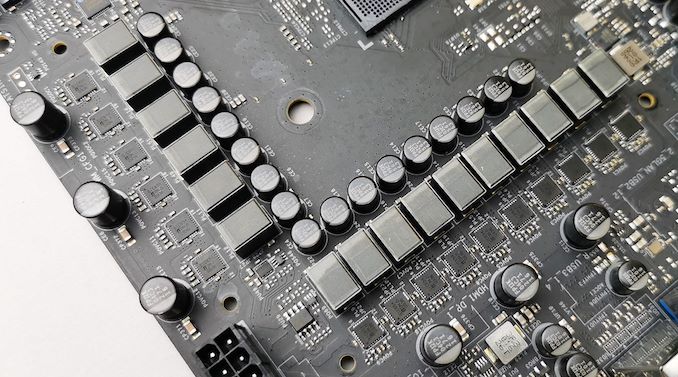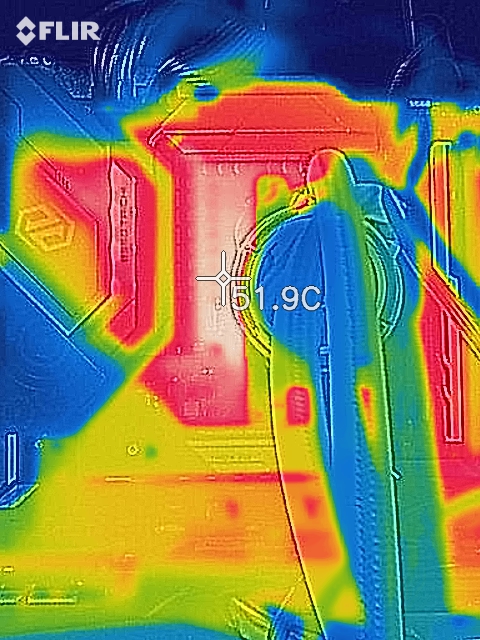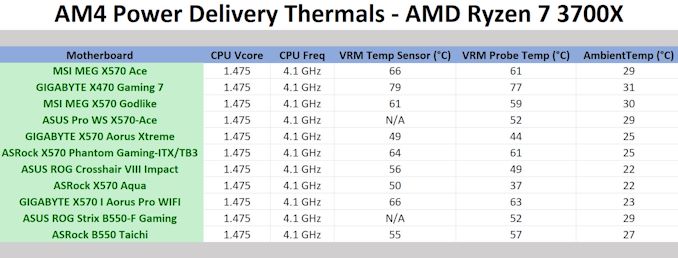ASRock B550 Taichi Review: The $300 B550 Motherboard with Chutzpah
by Gavin Bonshor on August 21, 2020 3:30 PM EST- Posted in
- Motherboards
- AMD
- ASRock
- Taichi
- AM4
- Ryzen 3000
- Ryzen 3700X
- Ryzen 4000
- B550
- B550 Taichi
Power Delivery Thermal Analysis
One of the most requested elements of our motherboard reviews revolves around the power delivery and its componentry. Aside from the quality of the components and its capability for overclocking to push out higher clock speeds which in turn improves performance, is the thermal capability of the cooling solutions implemented by manufacturers. While almost always fine for users running processors at default settings, the cooling capability of the VRMs isn't something that users should worry too much about, but for those looking to squeeze out extra performance from the CPU via overclocking, this puts extra pressure on the power delivery and in turn, generates extra heat. This is why more premium models often include heatsinks on its models with better cooling designs, heftier chunks of metal, and in some cases, even with water blocks.

The 16-phase power delivery operating at 7+1 on the ASRock B550 Taichi
Testing Methodology
Out method of testing out if the power delivery and its heatsink are effective at dissipating heat, is by running an intensely heavy CPU workload for a prolonged method of time. We apply an overclock which is deemed safe and at the maximum that the silicon on our AMD Ryzen 7 3700X processor allows. We then run the Prime95 with AVX2 enabled under a torture test for an hour at the maximum stable overclock we can which puts insane pressure on the processor. We collect our data via three different methods which include the following:
- Taking a thermal image from a birds-eye view after an hour with a Flir Pro thermal imaging camera
- Securing two probes on to the rear of the PCB, right underneath CPU VCore section of the power delivery for better parity in case the first probe reports a faulty reading
- Taking a reading of the VRM temperature from the sensor reading within the HWInfo monitoring application
The reason for using three different methods is that some sensors can read inaccurate temperatures, which can give very erratic results for users looking to gauge whether an overclock is too much pressure for the power delivery handle. With using a probe on the rear, it can also show the efficiency of the power stages and heatsinks as a wide margin between the probe and sensor temperature can show that the heatsink is dissipating heat and that the design is working, or that the internal sensor is massively wrong. To ensure our probe was accurate before testing, I binned 10 and selected the most accurate (within 1c of the actual temperature) for better parity in our testing.
For thermal image, we use a Flir One camera as it gives a good indication of where the heat is generated around the socket area, as some designs use different configurations and an evenly spread power delivery with good components will usually generate less heat. Manufacturers who use inefficient heatsinks and cheap out on power delivery components should run hotter than those who have invested. Of course, a $700 flagship motherboard is likely to outperform a cheaper $100 model under the same testing conditions, but it is still worth testing to see which vendors are doing things correctly.
Thermal Analysis Results

We measured 51.9°C on the hottest part of CPU socket area during our testing
The ASRock B550 Taichi is using a 16-phase design which is operating in a 7+1 configuration with an Intersil ISL229004 8-phase PWM controller. It is using fourteen Vishay SiC654 50 A power stages for the CPU and two SiC654 50 A power stages for the SoC. The CPU section is using seven ISL6617A doublers, while the SoC section is using a single ISL6617A doubler which makes the B550 Taichi's power delivery a 7+1 design. The power delivery is cooled by a pair of heatsinks connected by a single heat pipe which relies on passive airflow within a chassis.
In our power delivery thermal testing, the ASRock B550 Taichi performs quite well against other AM4 boards on test. Our testing shows that the Taichi's 16-phase design is rather efficient, which puts it ahead of some high-end X570 models which is impressive. The Taichi includes a dedicated temperature sensor for the power delivery which in our testing displayed a reading of 55°C, while our K-type probe mounted to the rear of the power delivery measured a reading of 57°C. Using our FLIR thermal imaging camera, we measured a 51.9°C on the hottest part of the CPU socket area, which shows that the cooling properties of the heatsink is efficient at dissipating heat. For a B550 motherboard, the results are competitive, and that the ASRock B550 Taichi is a very competent board for overclocking.











61 Comments
View All Comments
Irata - Saturday, August 22, 2020 - link
You also have x4 PCIe 4.0 plus several USB ports connected directly to the CPU with Ryzen. There is an Aorus board that allows the x8 plus three times x4 for nVME connection all directly from the CPU.If the Ampere and RDNA2 only need the bandwidth provider by 8x PCIe 4 / 16x PCIe 3, you can run the GPU and three nVME at full speed that way, plus USB devices connected to the CPU *and* still have the x4 PCIe 3 lanes for the chipset to CPU connection for everything else on B550.
I'd say this is where Ryzen 2 and 3 shine vs the competition that is much more limited with PCIe 3 and four fewer lanes from the CPU.
Death666Angel - Saturday, August 22, 2020 - link
I'm curious, what would be your use case for two x8 slots? Multi GPU is dead and are there any peripheral cards that need an x8 slot from the CPU? :)MrVibrato - Sunday, August 23, 2020 - link
There are x8 HBAs / RAID controllers.So, if one wants to use a GPU and such a HBA / RAID controller, two available x8 slots can make sense...sandtitz - Friday, August 21, 2020 - link
"...and the slightly older Intel AX200 [vs AX201]"According to Intel ARK, they're both the same product, released at the same time. Only the system connectivity differs.
No reason to prefer either.
invinciblegod - Friday, August 21, 2020 - link
What does system connectivity mean?dotes12 - Friday, August 21, 2020 - link
I think that Intel's AX200 does Wi-Fi through PCI-E and Bluetooth through USB, while Intel's AX201 uses CNVi for both in one CNVio link. I might have the 200/201 numbers reversed, but that's the idea as far as I understand it.Hyoyeon - Friday, August 21, 2020 - link
CNVi (intel proprietary) modules are often soldered, so I prefer the AX200.jabber - Saturday, August 22, 2020 - link
I must admit for me the PCIe slot setup I'd prefer is1 x 16
4 x 4
More practical for my use. Boards come with way too many 16 and 1 slots for my liking. The x4 slot is underappreciated.
Gigaplex - Saturday, August 22, 2020 - link
x4 cards fit in an x16 slot. There's not really much benefit in putting a physical x4 slot on the board - may as well just put an x16 slot and have it share lanes with some of the other slots, dropping down to x4 active.jabber - Monday, August 24, 2020 - link
Ahhh well you see I want to just have SET slots. I don't want that "if X is in Y then V is x4 or disabled and if Y is in V then C is X16 and if X is in V then its x8 but if you have NVMe in Slot B its disabled" nonsense.